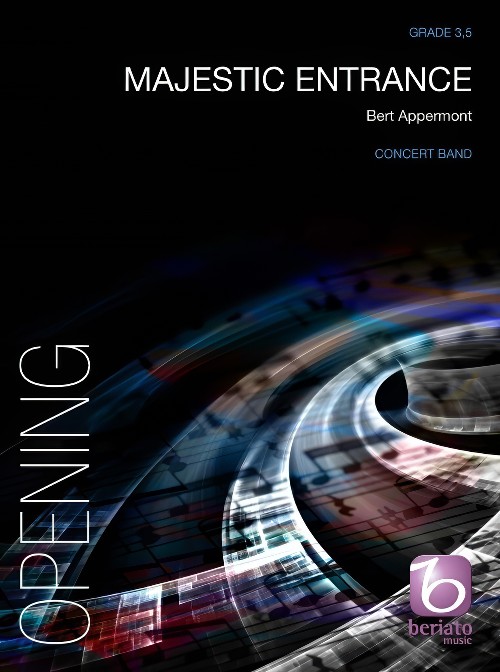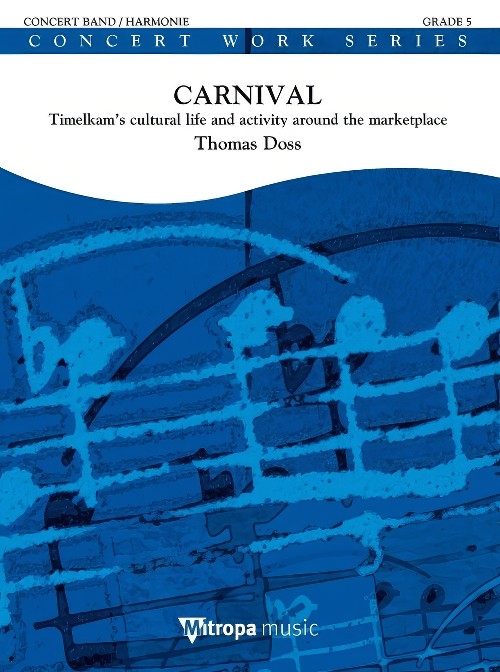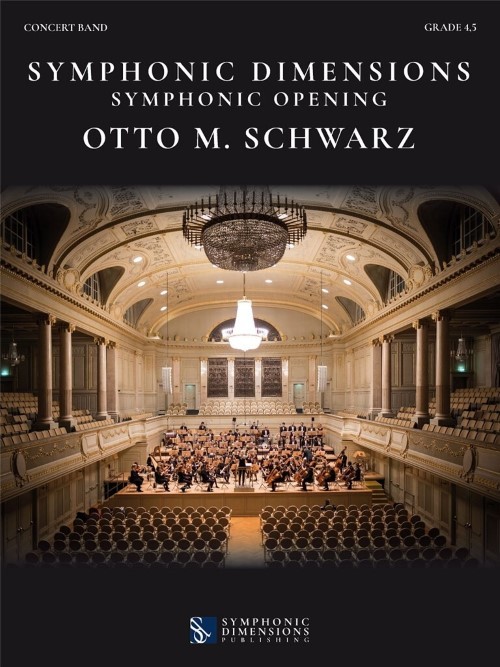Results
-
 £84.99
£84.99Jazzimut - Marc Jeanbourquin
In 2009, one year after its formation, the Swiss brass ensemble Azimuts Brass commissioned its conductor, Marc Jeanbourquin, to write them a signature tune. He composed Jazzimut, which features a festive introduction followed by a lyrical theme. After a few bars of rock rhythm, Jazzimut goes disco and finishes with a recapitulation of the introduction as a fanfare. Now available for concert band this is an entertaining piece from start to finish!
Estimated dispatch 7-14 working days
-
 £110.99
£110.99Second to None - Philip Sparke
Second to None is a perfectly suitable title for this work, though it actually refers to "Nulli Secundus", the motto of the British Corps of Army Music, who gave the commission to Philip Sparke. The piece opens with a fanfare, followed by two short quotes from two of the Corp's own marches and a festive Vivace. A more legato central section creates a nice contrast before the work closes with the opening fanfare. A perfect affair!
Estimated dispatch 7-14 working days
-
 £76.99
£76.99Viva La Musica - Hermann Pallhuber
Viva La Music--A joyous Hymn and Dance--is a cheerful piece of some 3:20 in length. It is comprised of two parts: a festive hymn with a recurring theme and a dance in the style of a lively jig. Thanks to its melodic character, its positive mood and its punchy wit Viva La Musica can equally serve as a short opening piece or as a finale. This work can even be played by a very small ensemble and, due to its lyricism and simple structure, it is especially suitable for youth wind band.The composer has dedicated Viva La Musica to the town of Fritzens in Tirol (Austria) and to its music guild.
Estimated dispatch 7-14 working days
-
 £149.99
£149.99Moretus - Bart Picqueur
Jan Moretus (1543-1610) was a book printer and publisher in his native city of Antwerp. He worked as assistant to his father-in-law, the renowned master printer and publisher Christoffel Plantijn. After Plantijn's death in 1589 Moretus took over the business.The composition Moretus consists of four parts that draw on the remarkable personality of Jan Moretus aswell as the printing business. In both the titles of the movements and the thematic structure we can see a certain symmetry: a playful allusion to the process of printing.Part 1, A Celebrated Gentleman, describes the illustrious figure of Moretus in a festive chorale. In the second part, ExpressiveImpressions, the printing press itself is brought to life in repeated motifs - despite the industrial, mechanical nature of the process, the product always has an artistic and cultural dimension. In the third part, Impressive Expression, the wind band is invited (or challenged), to intone the slow theme with a poignant expressiveness. Part 4, A Gentle Celebration, is a celebratory finale with a fresh theme.
Estimated dispatch 7-14 working days
-
 £134.99
£134.99Fanfare And Funk - Oliver Waespi
This work by Swiss composer Oliver Waespi was one of the highlights at the 2006 Eidgenssische Musikfest in Lucerne. The piece opens with a festive fanfare featuring the brass section. The mood changes to a funk passage which develops and grows into a James Brown-like groove. It also includes an ad libitum drum solo. A slow blues lends a calmer feel and the piece culminates with striking interwoven fanfare and funk styles. This work is highly recommended for concert programmes but it can also make a spectacular, unconventional choice for a competition.
Estimated dispatch 7-14 working days
-
 £144.99
£144.99Ross Roy - Jacob de Haan
Jacob de Haan was commissioned to compose this concert piece by the "St. Peters Wind Symphony" from Brisbane, Australia. "Ross Roy" is the monumental late 19th century villa where St. Peters Lutheran College was founded in 1945. The villa has always remained the school symbol. In this composition, Jacob de Haan sees the "Ross Roy" as a metaphor for the years spent at school (a monument in time), where one's personality is formed. So, the opening theme the artist calls the Ross Roy theme initially has monumental characteristics.The rhythmic motion, which strides along in the lower register and percussion at the beginning of the next section is typical of "Tempo di Marcia". Thismovement, accompanied by repetitions of sound, is a metaphor for the structure and discipline in school. This is the introduction to a march theme, symbolic of "passing through" the classes up to the final examinations.Then, the Ross Roy theme is dealt with again, now in a playful, humorous variation. As if the composer is saying there should also be time for a smile in school. The same theme can be heard in major key and a slower tempo in the following section, expressing pride and self-confidence. This is also the introduction to the expressive middle section that represents love, friendship and understanding.We then return to the march theme in a slightly altered construction. The oriental sounds, constituting the modulation to the final theme, are symbols of the diversity of cultures in the school. The characteristic final theme first sounds solemn, but turns into a festive apotheosis. It is no coincidence that the final cadence is reminiscent of the close to a traditional overture, for the school years can be considered the "overture" to the rest of one's life. The premiere of "Ross Roy" was conducted by Jacob de Haan in Brisbane, on August 22, 1997.
Estimated dispatch 7-14 working days
-
 £89.99
£89.99Minerva - Jan Van der Roost
Minerva by Jan Van der Roost was composed on the commission of the German "Musikverein Braunshausen" on the occasion of the 75th anniversary of the orchestra. The composition, first performed on September 17, 1999, is not a street march but a concert march, just like Mercury and Arsenal. The use and variation of different rhythmic patterns gives the first part of this march a distinctly dynamic character. Two main themes are presented in several instrumental combinations. The theme from the trio, on the other hand, is characterized by a broad melodic approach using large intervals. This theme, wreathed by high woodwinds, is heard one more time after a contrasting newpart, but now in a somewhat slower tempo. The counterpoint in this part refers to the first part of the march. The brilliant ending suits a festive anniversary march!
Estimated dispatch 7-14 working days
-
 £87.99
£87.99Majestic Entrance (Concert Band - Score and Parts) - Appermont, Bert
Majestic Entrance is a festive opening work with cinematic influences. It was written for the Swiss Musikverein Muttenz; this music society celebrated its 125th anniversary in 2021, more than enough reason for a commissioned composition. The work consists of three movements: a heroic opening passage, a lyrical middle movement and a return to the opening. All in all a composition of majestic charm! Duration: 4.15
Estimated dispatch 7-14 working days
-
 £159.99
£159.99Carnival (Concert Band - Score and Parts) - Doss, Thomas
This work was commissioned by Marktmusik Timelkam to celebrate its 170th anniversary. It describes the cultural life and hustle and bustle of the band's home base, the Austrian town of Timelkam. Carnival pictures a festive procession starting at the marketplace and lasting well into the night. The work features many carnivalesque elements and is a joy for players to perform. There is a lot of merry activity going on in the music; people cheerily chatting in the inn; singing and dancing together and having fun. There is also room for a melancholy mood, accompanied by reminiscences about eternal goodbyes and searching for love. With the added musical representation of children's playing and pranks, a beautiful sunrise as well as a depiction of the churches and societies in town, this composition is not just an account of a carnival parade but a small portrayal of life.Duration: 11.30
Estimated dispatch 7-14 working days
-
 £100.80
£100.80Symphonic Dimensions (Concert Band - Score and Parts) - Schwarz, Otto M.
Symphonic Dimensions is a powerful opening piece with a continually recurring motif. Beginning with a festive fanfare in which the leitmotif is heard for the first time, it continues in a buoyant 12/8 meter. The themes alternate again and again, in various instrumentations, and end in an epic finale. Symphonic Dimensions can equally be played at the end of a concert as a rousing finale.Duration: 4.00
Estimated dispatch 7-14 working days
